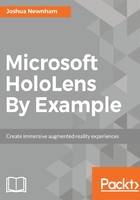
上QQ阅读APP看书,第一时间看更新
Thinking in terms of the real world
The luxury of designing for screen-based experiences is that your problem is simplified. In most cases, we own the screen and have a good understanding of it; we lose these luxuries with MR experiences, but gain more in terms of flexibility and therefore opportunity for new, innovative experiences. So it becomes even more important to understand your users and in what context they will be using your application, such as the following:
- Will they be sitting or standing?
- Will they be moving or stationary?
- Is the experience time dependent?
Some common practices when embedding holograms in the real world include the following:
- Place holograms in convenient places--places that are intuitive, easily discovered, and in reach, especially if they are interactive.
- Design for the constraints of the platform, but keep in mind that we are developing for a platform that will rapidly advance in the next few years. At the time of writing, Microsoft recommends placing holograms between 1.25 meters and 5 meters away from the device, with the optimum viewing distance of 2 meters. Find ways of gracefully fading content in and out when it gets too close or far, so as not to jar the user into an unexpected experience.
- As mentioned earlier, placing holograms on contextually relevant surfaces and using shadows create, more immersive experiences, giving a better illusion that the hologram exists in the real world.
- Avoid locking content to the camera; this can quickly become an annoyance to the user. Rather, use an alternative that is more gentle, an approach being adopted has the interface dragged, in an elastic-like manner, with the user's gaze.
- Make use of spatial sound to improve immersion and assist in hologram discovery. If you have ever listened to Virtual Barber Shop Hair Cut (https://www.youtube.com/watch?v=8IXm6SuUigI), you will appreciate how effective 3D sound can be in creating an immersive experience and, similar to mimicking the behavior of the objects you are trying to impersonate, use real world sound that the user will expect from the hologram.
The spatial sound, such as 3D, adds another dimension to how sound is perceived. Sounds are normally played back in stereo, meaning that the sound has no spatial position, that is, the user won't be able to infer where in space the sound comes from. Spatial sound is a set of techniques that mimic sound in the real world. This has many advantages, from offering more realism in your experience to assisting the user locate content.
Of course, this list is not comprehensive, but has a few practices to consider when building MR applications. Next, we will look at ways in which the user can interact with holograms.